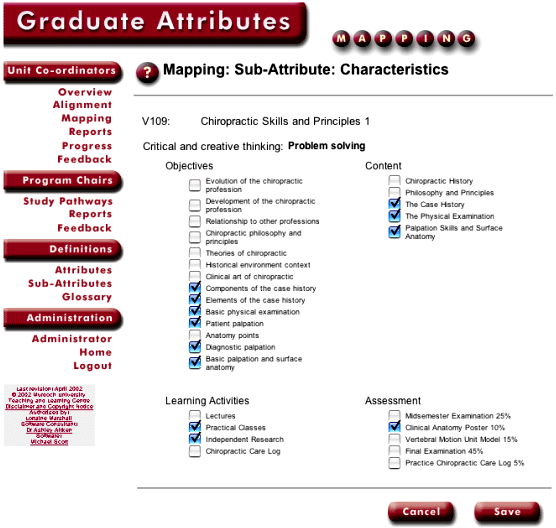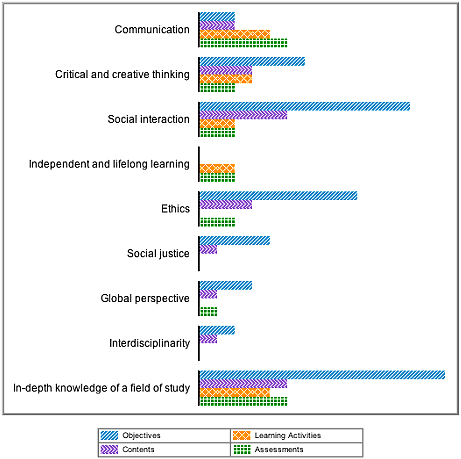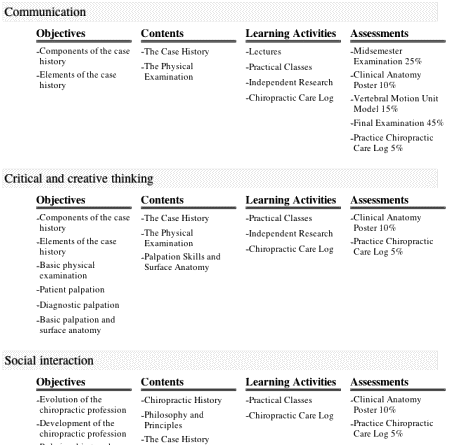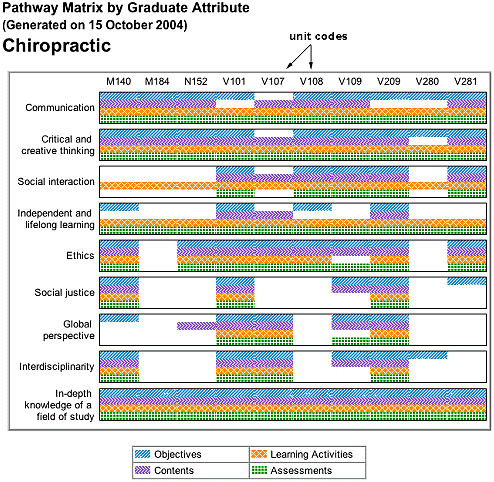
 |
| [ ASCILITE ]
[ 2004 Proceedings Contents ] |
This paper shows how technology coupled with a staff development strategy and legitimated by university strategic and quality assurance mechanisms can push boundaries and question comfort zones in a contested area. The paper explains how a web based graduate attribute mapping tool developed by Murdoch University has been harnessed with common sense and informed staff development strategies to facilitate reflection and renewal of curriculum for both individual units and courses of study.
This paper describes how a web based graduate attribute mapping tool has been used with a number of staff development strategies to push the boundaries of curriculum development and question the comfort zones of individual academics. The Graduate Attribute Mapping Program (GAMP) is a key part of the School Development Process (SDP), a university-wide strategic process led from within the Teaching and Learning Centre (TLC). The SDP is designed to assist Schools of Study across Murdoch University prepare for their five yearly review. School reviews are a key university quality assurance mechanism and one of the major objectives of the SDP is to ensure that undergraduate curriculum renewal occurs prior to School reviews. Thus, the potential for change and development in teaching and learning is being facilitated across the university and has the full support of management. The SDP includes a number of processes but the GAMP tool is pivotal in pushing boundaries as it brings a university-wide teaching and learning development strategy into the office and to the desk of every individual academic on a five yearly rotational basis. It is here, using GAMP for unit by unit mapping with individuals, that teaching and learning staff attempt to provide an environment for reflection on, and support for, changes to curriculum practices. The SDP subsequently brings the information generated by individuals using this tool into staff workshops for analysis and discussion. Thus, with individuals and in groups the potential arises to push boundaries and question comfortable practices in curriculum development and renewal.
Divergent views about, and attitudes towards, graduate attributes have been expressed since the early 1990s. In line with their overseas counterparts, Australian universities began defining and endorsing their own lists of graduate attributes or qualities and began to a lesser or greater extent to embed them in the curriculum. Debate about graduate attributes at Murdoch University came from a range of areas across the university and from a range of perspectives. These arguments can be summarised as political, semantic and those related to university process.
Firstly, there was resistance to the politics of graduate attributes. In some quarters opposition was voiced to what was seen as university management following Government driven attempts to institute further control and surveillance mechanisms under the guise of accountability. It was feared that this move has the potential to establish key competencies for undergraduate studies. In these same quarters some staff, while acknowledging the need for students to be employed, argued that graduate attributes reflected a Government agenda to shift the educational mission of the university to graduating students with vocational skills at the expense of other educational goals. Indeed, many of the federal employment reports (Curtis and McKenzie, 2001; Field, 2001; McInnis and James, 2002) pointed to the need for universities to graduate students who were directly prepared for the workplace. Dissenting voices came primarily from non-vocational areas of the university. This was not an issue in professional disciplines, such as Engineering, who were well accustomed to meeting professional accreditation standards and showing how a degree program develops the employment skills of undergraduates. International examples were also used here to support or question Murdoch's involvement with graduate attributes. Some staff quoted what they saw as the failure of this process elsewhere. Others pointed to the exemplary way the lists are used in North American institutions with Alverno College [1] and its comprehensive list providing a prime example.
Secondly, at a semantic level questions were raised about the meaning and definition of the graduate attributes themselves. Clanchy and Ballard (1995) highlight the problem in defining graduate attributes which lump together 'personal qualities, generalised capacities, individual attitudes, value systems, professional competencies, higher order generic skills and lower order technical ones'. In 2000 when Murdoch University endorsed a list of 7 attributes this definitional problem became apparent, with concerns about: the collapsing of skills, attitudes and values, the range of possible interpretations of the terms for different disciplines (and the lack of guidance on this) and inconsistencies and gaps in the list. For example, Mathematics criticised the omission of numeracy. In addition, some staff wanted clarity on the levels of achievement expected on graduation. In 2003 the list was revised and rewritten and these problems addressed. At this time it was also decided to leave it up to individual courses of study to define what each attribute meant within a discipline and the level students were expected to achieve.
A third area of contention focused on the way the university had dealt with graduate attributes. In 2000 when Murdoch University's Academic Council accepted the set of attributes, it also required that every core unit of study in the university be mapped against these attributes by the end of 2001. Guidance on how the mapping was to be done was minimal (other than an example from the School of Environmental Science), no leadership was suggested, no funding provided, and no links were made between graduate attributes and teaching and learning. On the surface, the focus of graduate attributes seemed to be on mapping (i.e. accountability) and it was unclear how mapping would subsequently lead to integrating the attributes into the curriculum. Resistance to graduate attributes was further entrenched when the largest division in the university (where much of the criticism was voiced), mapped most of their units using a process that met the university's requirement but fell far short of providing any useful information that could lead to embedding graduate attributes into the curriculum. Staff who went through this initial process were then reluctant to participate in the university-wide system developed later. Add to all of this, funding shortages, increasing teaching loads and a range of other unresolved issues for academic staff, and the extent of the challenge to bring about curriculum change using graduate attributes comes into clearer focus.
Finally, Murdoch University had for several years been rated (and continues to be rated) by the Good University's Guide as the top teaching university in the country. Because of this many concluded that 'as we are teaching so well, we do not need to bother with graduate attributes'. Many staff would say 'why do we need to map the attributes, when we already have them in our units'. In other words, we are already doing well and the only reason for mapping units must be accountability.
Thus, we have a highly contested topic with sites of resistance and acceptance, and little awareness of the potential for graduate attributes mapping and implementation to improve teaching and learning.
A major breakthrough came when a senior staff member in the TLC took responsibility for implementing a coordinated approach to the university's graduate attributes agenda and set about developing a mechanism to map the attributes and a process to link graduate attributes to improving teaching and learning. Shortly after this, university funding was provided for graduate attribute projects, and when Academic Council required School reviews to report on graduate attributes, mapping was embedded in the quality assurance mechanisms of the university. The graduate attribute agenda was further enhanced when the SDP was instituted on a university wide basis and was directly linked to the rolling School review agenda. The time was then ripe to use the GAMP tool as a major teaching and learning vehicle for curriculum renewal across the university.
Several approaches were used to further the graduate attribute agenda and to develop a tool and a process:
It is worth noting that the tool was specifically designed to be easy to use and so that mapping would take as little time as possible. The program was originally designed for staff to input their own data and map their units. But it quickly became clear that it was not feasible to expect this from over stretched academic staff and when the whole notion of graduate attributes was such a contested area in its own right. Some staff can and do use the program but to date this use has been limited. After mapping, staff are encouraged to use the GAMP as a design tool.

Figure 1: Graduate attribute mapping program template for unit V109 [3]
Items on the template are abbreviations of what appears in the unit guides
The mapping tool generates several printable reports:

Figure 2: Graduate attributes graph report

Figure 3: Graduate attributes text report (excerpt)
The same overview information is used to generate a second template for mapping the unit learning activities, content and assessment to the learning objectives. Again there are printable reports:
As indicated earlier GAMP is used in two contexts: with individual staff and with course (or School) teams of staff. The staff development strategy used with individual staff has several features.
Firstly, a deeper agenda becomes apparent during mapping the graduate attributes because the process also addresses broader curriculum development issues. Staff in Schools are not immediately aware of this, and meetings with Teaching and Learning staff under the guise of mapping graduate attributes naturally elicits discussion of issues related to unit design and teaching practice. It is our experience that this approach to curriculum design through mapping the attributes is less threatening to staff and more effective in working with a wider range of staff than approaching curriculum design directly or in isolation.
Secondly, it has been necessary to stress that the mapping process is about improving learning and teaching and to play down the role of accountability in collecting the information for School reviews. The overall advantages of gathering graduate attribute information for the development of individual units and for the course as a whole is emphasised. Showing examples of a course pathway matrix is useful here. In whole of School meetings the process is explained and discussion is facilitated.

Figure 4: Pathway matrix report
Thirdly, as this is a School and discipline based process it is important to acknowledge and work alongside (and not against) the disciplinary differences and the related conceptions of learning and teaching held by staff. In addition, it appears much of the resistance and compliance to graduate attribute is closely linked to disciplinary groups, although this is not uniformly the case. Becher's (1989) work on tribes and territories has been useful in informing our understanding of the disciplines, and Trowler and Cooper's (2003) analysis of the complexities of different teaching and learning regimes informs our staff development process. Prior to the establishment of the SDP, sympathetic staff from within disciplinary areas were used to map the graduate attributes in a 'bottom up' approach. We ask facilitators to be aware of the different assumptions and attitudes to teaching and learning held by academic staff, and how these affect practice.
Fourthly, the mapping process includes time for reflection and with it a guided and supported process of questioning and assessing how graduate attributes are developed in a unit. The mapping facilitator who is usually unfamiliar with the unit apart from checking the overview report asks clarifying questions that delve into the unstated goals and expectations of the coordinator. The mapping process requires that staff examine their units from two different perspectives: firstly by taking key features of the unit to determine if and where graduate attributes are developed, and then by examining the curriculum alignment. When considering whether or not to tick if a sub-attribute is covered, coordinators metacogitate and articulate their attitudes to learning and teaching, their practices and what they are hoping to achieve at both the macro and micro levels in the unit. It is apparent that many academics focus on the content and few actually specify in study materials their deeper aims or the generic skills they wish to develop. Mapping attributes helps Unit Coordinators articulate these, highlights any problems with alignment and indicates where objectives have been omitted. The tool allows alteration of the template and staff can make and implement enhancements to their unit information on the fly and with assistance from a TLC facilitator. Thus, using the alignment feature of the tool becomes a confirmation of the mapping, as most coordinators are already aware of any shortfalls in their statements of objectives and alignment.
Finally, affirmation by mapping facilitators has been crucial to the process. Suggestions are made carefully and where ever possible positive feedback is given to staff. For example, individual coordinators are invited to identify best practice strategies that they use to develop attributes and these are included in the TLC developed graduate attribute resource data base [4]. All facilitators recognise that if we overcome resistance, in that alone we are pushing boundaries and increasing the potential for curriculum change. We recognise that we will alienate if we ask too much of coordinators and if we are over critical. Feedback sheets are provided indicating areas for change, but the extent of the changes suggested depends entirely on the staff member's readiness.
The message to individual staff is that they are already doing an excellent job (why else would we be a five star university) and this should be documented. The results of this mapping are then used to inform how the attributes are scaffolded and developed across a degree course.
Overcoming resistance has been a major objective so it has been important to listen to staff, respond to their concerns, and adjust the process as required. Facilitators continue to report that staff who were initially resistant have quickly warmed to the process, particularly if they perceive it will benefit students and improve their teaching. (Systematic survey of staff response to the process will be made available when completed.) Because graduate attribute mapping is a university requirement, staff are also grateful for the assistance provided by the TLC to alleviate the burden on them.
Facilitators work with many coordinators who have not fully articulated in unit materials the extent to which they are developing student's generic skills and covering the graduate attributes. Staff have been willing to make changes to their study guides to reflect this.
Discussion during mapping often focuses on the need to articulate learning objectives clearly. The more clearly learning objectives are stated in unit guides, the more easily students can access and understand the unit expectations. (Allan, 1996) Without clear learning objectives, mapping and alignment cannot be carried out, so identifying and clarifying learning objectives needs to be negotiated early on. While this is sometimes a delicate process it is potentially very fruitful because it lies at the core of a unit's purpose and is a key to discussion of approaches and attitudes to teaching and learning
In summary, even with the tool and the staff development strategies this process would not have been so effective if senior management had not been behind it and directly linked it to School reviews. This has provided the imperative which has created challenges for its various participants and has highlighted the diversity of issues, attitudes and engagement in curriculum development and renewal.
Useful contrasts in the effectiveness of GAMP and the process it supports is evident in working with the Schools of Chiropractic and Social Sciences and Humanities, with the former being a site of compliance and the latter with areas of considerable resistance to the process. Chiropractic is a new school which took its first cohort of students in 2001. All units are compulsory and the staff is small, close knit and new to the university. Staff were immediately receptive and valued the assistance provided by the TLC at both an individual and School level. In contrast, the School of Social Sciences and Humanities, a recently restructured and very large school, has a high proportion of long established staff from a wide range of disciplines. The courses in many cases provide extensive choice and require few core units. This complicates the scaffolding of graduate attributes. The introductory, whole of School meeting became a forum for debate on the graduate attributes and the SDP, with over worked staff expressing disquiet about the additional burden on them. Meetings with individuals to date, however, have been largely positive with staff appreciative of the support being given. Anecdotal evidence suggests the process is indeed providing a way for them to reflect on their curriculum and their teaching, and obtain personalised assistance to make changes.
The School Development Process combines the use of a web based tool with common sense staff development strategies that are informed by research on teaching and learning. Both the tool and the strategies aim to win over individuals and groups of academic staff to the value that mapping the graduate attributes brings to their teaching and to students' learning. The web based tool has been pivotal to this process. By illustrating that there is a direct link between graduate attributes and teaching and learning, GAMP has also demonstrated its usefulness in curriculum development and renewal at both the unit and course levels.
Becher, T. (1989). Academic tribes and territories. Milton Keynes, Open University Press.
Clanchy, J. and Ballard, B. (1995). Generic skills in the context of higher education. Higher Education Research and Development, 14(2), 155-166.
Cummings, R., Phillips, R., Lowe, K. and Tillbrook, R. (2004). Middle-out approaches to university reform: Champions striding between top-down and bottom-up approaches (In press.)
Curtis, D. and McKenzie, P. (2001). Employability skills for Australian industry: Literature review and framework development. Report to Business Council of Australia: Australian Chamber of Commerce and Industry, ACER. Melbourne. December. [verified 23 Oct 2004] http://www.dest.gov.au/ty/publications/employability_skills/literature_research.pdf
Field, L. (2001). Industry speaks: Skill requirements of leading Australian workplaces. Report on the Employability skills for the Future Project. [verified 23 Oct 2004] http://www.dest.gov.au/ty/publications/employability_skills/case_study.pdf
Hager, P., Holland, S. and Beckett, D. (2002). Enhancing the learning and employability of graduates: The role of generic skills. Business Higher Education Round Table. B-HERT Position paper no.9. [verified 23 Oct 2004] http://www.bhert.com/Position%20Paper%20No%209.pdf
Higher Education Council (1992). Achieving Quality. Canberra, AGPS.
James, B., Lefoe, G. and Hadi, M. (2004). Working 'through' graduate attributes: A bottom-up approach. Proceedings HERDSA 2004 Conference, Miri, Sarawak. [verified 23 Oct 2004] http://herdsa2004.curtin.edu.my/Contributions/RPapers/P022-jt.pdf
McInnis, C., James, R. and Devlin, M. (2002). Employability skills for the future. Department of Education, Science and Training and Australian National Training Authority and the Business Council of Australia and Australian Chamber of Commerce and Industry. [verified 23 Oct 2004] http://www.acci.asn.au/text_files/reports/Employability_Skills.pdf
Trowler, P. and Cooper, A. (2002). Teaching and learning regimes: Implicit theories and recurrent practices in the enhancement of teaching and learning through educational development programmes. Higher Education Research and Development, 21(3). 221-240.
| Authors: Kate Lowe can be contacted at K.Lowe@murdoch.edu.au Lorraine Marshall can be contacted at L.Marshall@murdoch.edu.au Please cite as: Lowe, K. & Marshall, L.(2004). Plotting renewal: Pushing curriculum boundaries using a web based graduate attribute mapping tool. In R. Atkinson, C. McBeath, D. Jonas-Dwyer & R. Phillips (Eds), Beyond the comfort zone: Proceedings of the 21st ASCILITE Conference (pp. 548-557). Perth, 5-8 December. http://www.ascilite.org.au/conferences/perth04/procs/lowe-k.html |
©2004 Kate Lowe & Lorraine Marshall
The authors assign to ASCILITE and educational non-profit institutions a non-exclusive licence to use this document for personal use and in courses of instruction provided that the article is used in full and this copyright statement is reproduced. The authors also grant a non-exclusive licence to ASCILITE to publish this document on the ASCILITE web site (including any mirror or archival sites that may be developed) and in printed form within the ASCILITE 2004 Conference Proceedings. Any other usage is prohibited without the express permission of the authors.